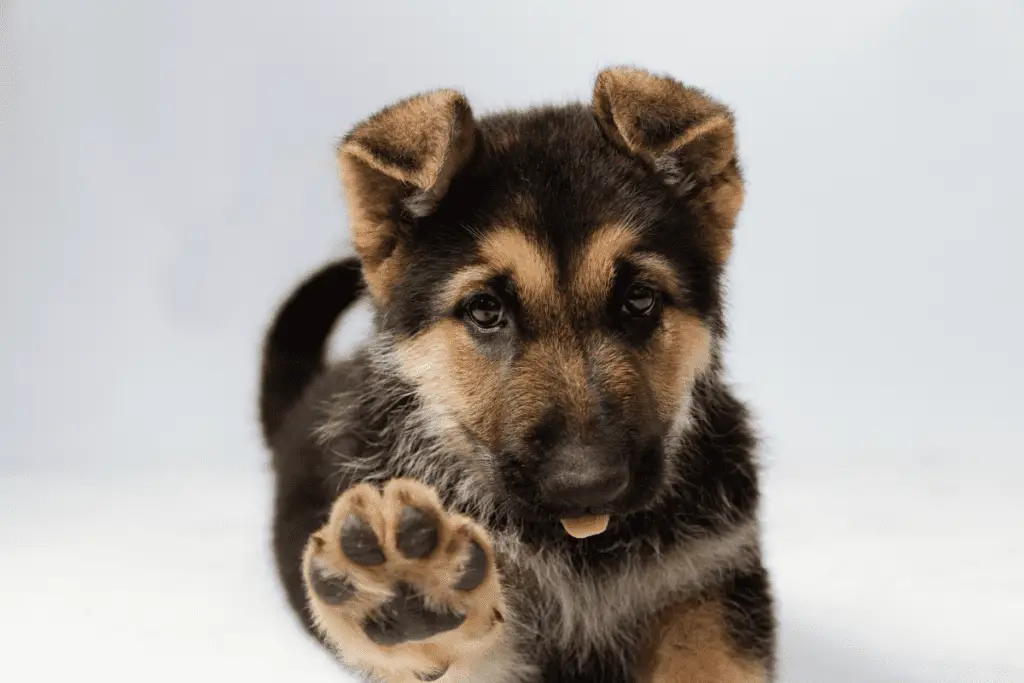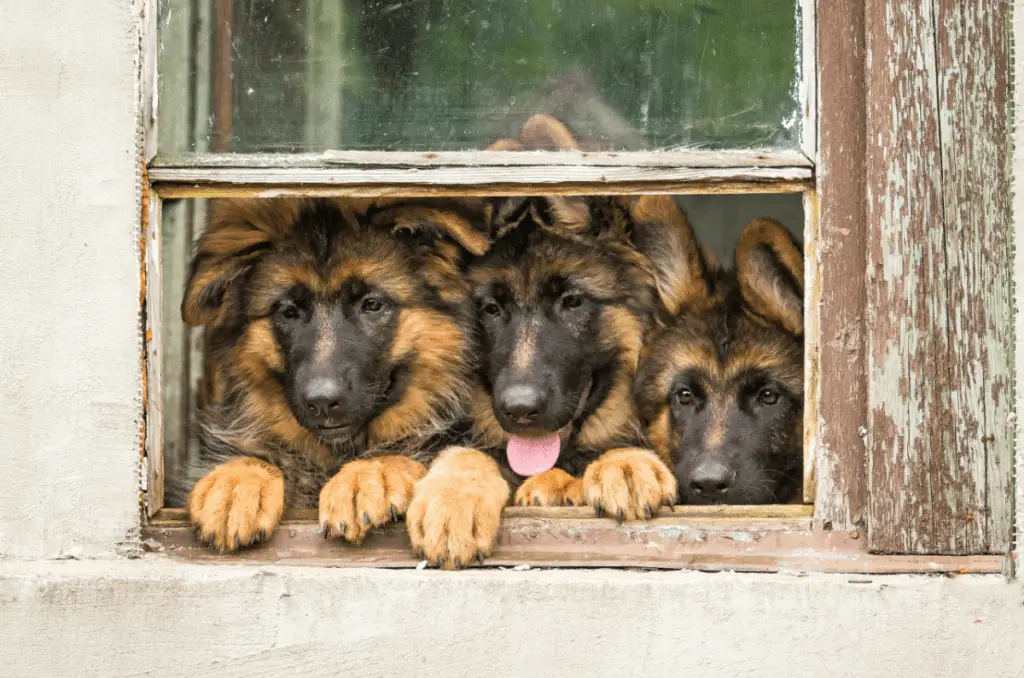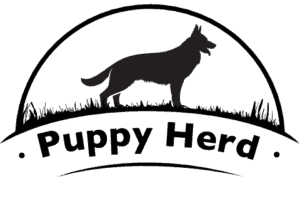As the proud owner of a German Shepherd Dog (GSD), you naturally want to be aware of the care and maintenance your pup requires. You also want to know how to perform them in a low-impact, low-stress way for both you and your dog. One of the tasks that concern many dog owners is clipping their pet’s nails safely and knowing how often is enough.
You should cut your German Shepherd’s nails once every six to ten weeks. For puppies, it is vital to build up and maintain your bond with the dog and offer positive reinforcement even if the cut needs to be done in stages. Ask your groomer how to do it at home safely, and never cut to the quick.
We’ll cover the ins and outs of cutting your German Shepherd’s nails. There’s a lot to consider, including whether to use a muzzle, how to access your dog’s feet and paws, and what tool to use.

How German Shepherd Paws Are Unique
Way back around the turn of the 20th century, two German gentlemen — Max von Stephanitz and colleague Arthur Meyer — established the “Verein für deutsche Schäferhunde” (abbreviated in English as SV), the Society for German Shepherd Dogs.
The point was to specifically focus on German Shepherds as their own breed, one that was deserving of a club that would publicize and maintain breed standards.
Today, the SV standards — along with the American Kennel Club and UK Kennel Club — generally dictate that German Shepherds have feet with short, dark claws and paws that are quite compact with a generous arch and thick, sturdy pads below the claws.
GSD claws often have extra-long middle toes and claws that help them jump into full running speed more readily than dogs with other toe structures. But it’s the dark coloration of the claws that concerns us. That’s because, in dogs with white or light claws, it’s easy to see where the tip of the claw ends and the “quick” (the cuticle) of the claw begins.
You are probably already aware of how painful it is for a dog when the groomer nicks the cuticle by cutting the nail too short. Your dog will react physically with fear or aggression when the quick is cut, and that’s not all — the bleeding will be hard to stop.
For the vast majority of GSD, you will need to perform a paw check and nail trim every six to ten weeks. This will vary depending on their lifestyle, meaning what kind of surfaces they usually walk on.
German Shepherd’s that are allowed to run around on asphalt or concrete will not need their nails trimmed as often, as the gritty texture of the solid floor will act as a nail-file, of sorts. In contrast, if your GSD is only running around on grass, they will need to be checked more frequently.
How To Approach Your German Shepherd For A Nail Trim
When it comes to approaching your GSD when it’s time for a nail trim, the key to success is to start as young as possible. If you’re lucky enough to have your GSD from a puppy, be sure to touch their paws gently while they sit beside you, to desensitize them from feeling uncomfortable.
To prepare your GSD for nail trimming, begin by simply showing them the clippers. Allow them to become comfortable with them near their paws, without actually using them, and give your dog plenty of treats. You can also desensitize them to the sound electric clippers make using an electric toothbrush.
Let’s walk through the safest and most gentle way to clip your German Shepherd’s nails.
Gather Your Clippers, Muzzle, Leash And Treats
First, make sure to gather all your tools before you make your dog aware of what they’re in for. Being prepared with everything within arm’s reach will reduce the stress and anxiety that your pup will feel before actually undergoing the procedure.
Approach Their Paws Slowly
As you constantly provide encouraging language in a gentle tone, you must remember to not suddenly grab your dog’s paw without warning. Instead, approach your German Shepherd slowly and start with some petting on the head and shoulder (for front paws) or hip and haunches (for the back paws) before lowering your hand to cradle the whole paw.
Following this guideline will reduce the chances of spooking your dog and eliciting a negative response.
Move Their Paws Comfortably
Don’t extend your dog’s paw for clipping in a way that is unnatural or uncomfortable for them. If you can, bend your dog’s leg conforming to how the joint operates normally, bringing the claws into view without discomfort. This often means having your German Shepherd stand and bringing their paws back, like you would a horse’s foot.
Stop If Your German Shepherd Appears In Distress
As part of your gentle approach, be prepared to stop when your dog begins to struggle, even if you’ve only clipped one or two nails up to that point. It’s much better to extend the clipping process over a few days than to try to force your German Shepherd into a situation where they will whine, struggle, or snap. Never betray your pet’s trust in you.

Avoid the Quick At All Costs
Nothing ends a canine nail-clipping event more quickly or miserably than when the owner or groomer cuts the claw too short and hits the quick. The dark claws of a Shepherd make it especially difficult to judge where the outer claw ends and the quick begins. And this is something you don’t want to test on a “trial and error” basis. It’s much better to err on the side of caution, clipping only a little off the ends of the nails.
Should disaster strike and you clip through the quick, two things will happen: your dog will yelp and try to escape, which is bad enough, but also you will lose a certain measure of their trust. The faithful companion allowed you to hold them in a vulnerable position, and their worst fears have been realized — their trusted master has brought them pain.
The second thing is that your dog’s paw will begin to bleed. If your dog is distraught, it will be very difficult to get them to allow you close again. You will likely need a lot of high value treats.
There are two things to do at this point: re-engage your dog’s trust and attention, and stop the bleeding. The former should be done with loving tones and plenty of treats, but for the latter, there are several good methods:
- A styptic pencil like this Clubman Jumbo — Styptic pencils and powders are specifically designed to stanch the bleeding from injuries like this. Be careful, because the initial application can bring a sting. Hold your dog firmly while you touch their paw to the source of aid and reapply as necessary.
- Cornstarch — This can be used in a mixture with baking soda or by itself. The process of application is similar to that of styptic powders — dip the affected paw in the cornstarch mixture, wait, and repeat if necessary. This is a good fallback if you don’t have the styptic solution available.
- Wet tea bag — The tannic acid in a tea bag can help clot the blood, ultimately stopping its flow. This method is most effective when the bleeding is minimal.
- Scent-free soap — Also best for minimal bleeding. Simply press the dog’s paw a few millimeters into the bar of soap and give the bar a turn to completely coat the source of blood.
- Veterinary assistance — If all else fails and you can’t stop your dog’s paw from bleeding after 20 or 30 minutes, call your vet and bring your German Shepherd in right away.
Best Clippers For German Shepherds’ Paws
There’s a lot to be said for having the right tools for the job. But there are also many tools that fit the description. To help you choose, here’s a list of some of the most popular claw-trimming implements, one for each — grinder, plier, and guillotine:
- Casfuy Dog Nail Grinder — This tool is essentially a Dremel grinder that specializes in grinding claws without all the other features. If you’re looking for a way to reduce the length of your German Shepherd’s claws in small increments with minimum stress, this tool is a good bet.
- Hertzko Dog Nail Clippers for Large Dogs — These are some of the most popular plier-style clippers on the market, featuring a guard to help avoid cutting the quick and an old-fashioned file for finishing up or working on the smaller nails.
- Pettom Cat and Dog Nail Clippers — This handy guillotine-style clipper has a stainless-steel cutter edge and also features a quick guard. When used properly, this style can deliver a quick and painless nail-cutting experience. This is a great tool when your pup is still young.
Generally speaking, when using the grinder, you should be trimming very little from your dog’s nails. As this will vibrate and have a sound from the motor, it can be upsetting if it is used for too long. The best option is to trim small amounts more often, than spend too long in one session.
Clippers and guillotine-clippers will take off more of the nail in a shorter time, and will result in you needing to trim their nails less frequently.
Final Thoughts
When cutting your German Shepherd’s nails, the most important thing is to always be gentle enough that they never feel you’ve betrayed their trust. Once every 6-10 weeks should be enough. Go slow, be thorough, and be patient, in the end your dog will be grateful.
